#it actually is a quantum-mechanical effect of the wavelength of light and interference patterns
Explore tagged Tumblr posts
Text
Iridescence is an optical phenomena where the color of a surface varies based on tiny changes in the angle you observe it at, creating a rainbow effect. It can be caused by having a very thin layer of a semi transparent material over another, such as oil over water, or a soap bubble over air. Moving even slightly can cause the 'rainbow' to move a lot, causing an unnatural-looking coloration.
A 'puddle at a gas station' is likely contaminated with oil or some other industrial chemical, causing an iridescent effect.
In the early twenty-first century, people will be familiar with iridescence on account of the many iridescent objects and insects, though they are unlikely to know the name of the effect.
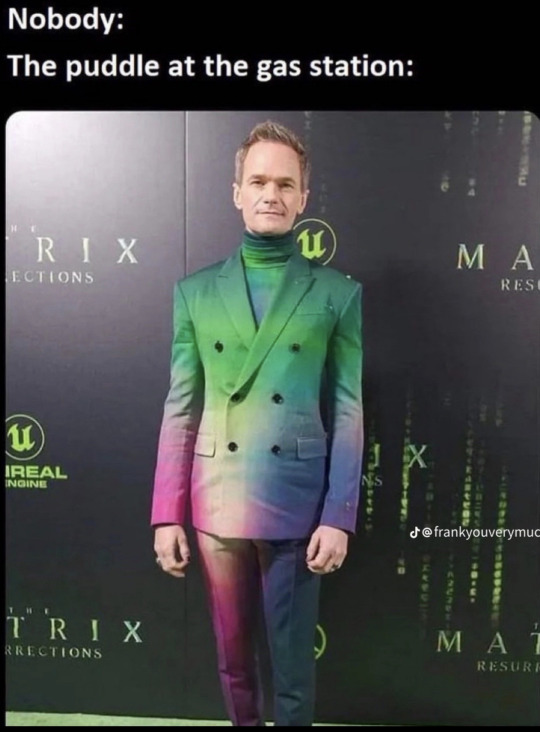
#period novel details#iridescence is a pretty recent innovation if computer graphics#it actually is a quantum-mechanical effect of the wavelength of light and interference patterns#of course all color is quantum-mechanical in nature#but you know what I mean
32K notes
·
View notes
Text
Wave-Particle Duality and the Dragon
A PHYSICS PRIMER AND A THOUGHT EXPERIMENT by John Alipio
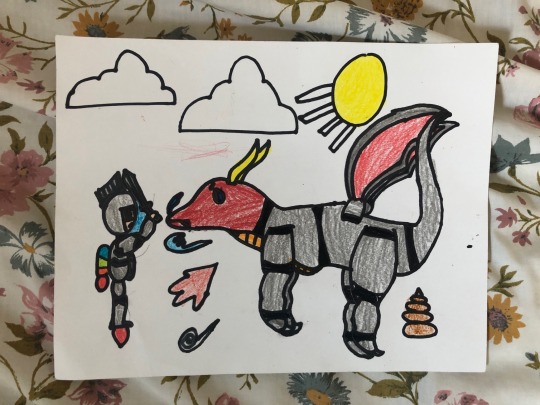
-Artwork by Oliver A.
The Double Slit Experiment
A fundamental mystery of quantum mechanics is wave-particle duality.
Waves and particles have very different properties. Multiple waves can exist in the same place at the same time, and they interfere with each other, meaning they cancel and amplify each other (e.g., sound and water waves). Particles, on the other hand, cannot be in the same place at the same time, and the energy of multiple particles is the sum of their individual energies (e.g., a baseball).
A wave-particle behaves as a wave in some circumstances and as a particle in other circumstances. It has both a wave nature and a particle nature. Light and the electron, which we will talk about further, are examples of wave-particles.
Thomas Young’s famous double split experiment is one way to demonstrate the wave-particle nature of light. To summarize, in this experiment, light is projected at a barrier which has two narrow slits. A screen is set up beyond the barrier to absorb the light after it passes through the slits. With a laser and some precise materials, this experiment can be easily replicated in a classroom.
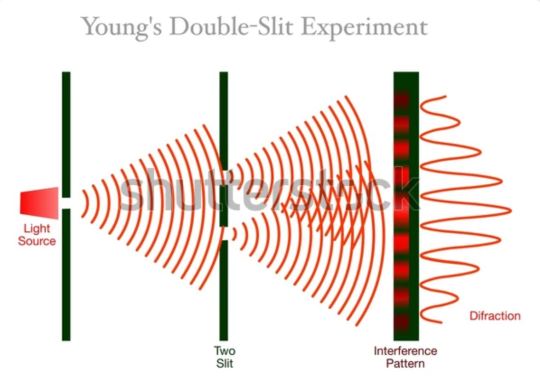
The light passes through both slits, and the resulting waves overlap with each other and interfere. That is, they amplify or cancel each other to create an interference pattern. Because they are identical waves in wavelength and frequency, they create a pattern like this on the screen.

This interference pattern is proof that light behaves as a wave.
However, when the light hits the screen, it behaves as a particle. The light gets absorbed by the screen as individual packets of energy we call photons. The energy of the photons add up as we would expect energy of particles.
Although much trickier to pull off, the double slit experiment for electrons works similarly. Individual electrons are fired through the double slits. At first, the pattern that the electrons create on the screen seems random, but as more electrons are fired, a clear interference pattern emerges, which would be indication that the electron is interfering with itself as if it moved through both slits as a wave.
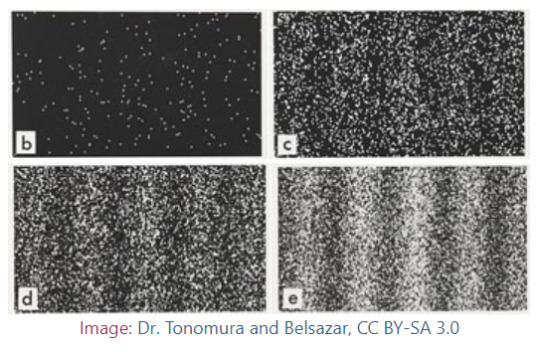
At the quantum level, the only way physics is able to describe and predict behavior is with mathematical probabilities. This means, when thinking about the electron, we have to allow for different possibilities to exist at the same time.
From a mathematical standpoint, there is a 50/50 probability that the electron will go through one slit or the other. The uncertain electron does not have to go through one slit or the other, so it is presumed to go through both slits (behaving like a wave).
Now introduce a detector which can record which slit the electron goes through. As soon as it records that information, the electron no longer has the “choice” of going through either slit or both slits. It must obey the laws of probability. The electron can only go through one slit. The pattern seems random again at the start, but as more electrons are fired, the pattern it creates is different. Instead of the wavy interference pattern we saw before, we see a pattern of two stripes, as if there was no interference with itself (behaving like a particle). This works the same with photons of light.

Marcus de Brun (https://physics.stackexchange.com/users/179575/marcus-de-brun), Double Slit Experiment. What effect does the detector actually cause? (https://physics.stackexchange.com/q/376494)
Light (and all other electromagnetic radiation) and electrons (and all other quantum objects) have wave-particle duality. Sometimes they behave as waves, sometimes they behave as particles. It depends on the circumstances in which they are detected.
The Dragon
You stand before a closed door, behind which there is a dragon. As the old maps depict, the dragon represents the unknown, the edges of our understanding.
No one knows for sure if the dragon exists or its shape, but the news of the dragon spreads through word of mouth, written word, movie, song. The thought of the dragon takes on a different shape for each person. Each has their own response— fear, curiosity, indifference, boldness. Their responses are individual, but as they interact with one another, their responses are magnified or diminished.
The dragon, for the time being, remains unconfirmed, but its impact is real. Like a wave, it rumbles through the community.
Suddenly everything changes, for you open the door and walk through. All the possibilities converge into one truth. The dragon will eat you, or it won’t.
The truth transforms you in a much more permanent way than the dragon behind the door. The truth leaves a mark.
Thanks for reading. Love,
John

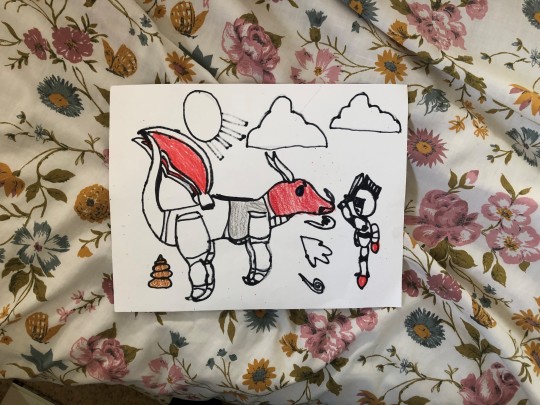
0 notes
Text
The Science of Magick: Implicate Order
“What is, is always a totality of ensembles, all present together, in an orderly series of stages of enfoldment and unfoldment, which intermingle and interpenetrate each other in principle throughout the whole of space.” David Bohm
Spooky Action at a Distance

In the 80s, theoretical physicists first observed the paradoxical behavior of subatomic particles known as quantum entanglement, or “spooky action at a distance” as Einstein called it. This phenomenon has been observed whereby the properties (quantum states) of a set of particles will never be independent of each other, regardless of distance, after they have interacted. This observation would be like taking a set of twins, dying one’s hair black, and then discovering that regardless of where the twins were located, the other’s hair turned black instantaneously as well. Spooky! This property of non-locality could not be explained by the current theory of quantum mechanics, so many physicists proposed their own respective models to explain the observations.
The theory of implicate order, and its counterpart explicate order, were detailed by physicist David Bohm in his book Wholeness and Implicate Order in 1980. Implicate order theory provides a model of the universe as an “unbroken wholeness of the totality of existence as an undivided flowing movement without borders" in which space and time as we observe them are merely derivatives (unfolded, explicate order) of the deeper reality. It sounds complex, but Bohm provides an illustrative example:

Imagine a fish in a tank with two separate cameras recording from two separate angles and projecting onto two separate screens. Now imagine you can only see the tv screens and not the actual fish; two 2D models (explicate orders) of a 3D objective reality (implicate order). By observing only the 2D models, one can discern that the “two” fish are somehow interrelated: when the fish on screen A moves 90 degrees, so does the fish on screen B, etc. It is not that one screen is causing the changes on the other screen, just that all of the image content on one screen correlates with the other.
If we scale up the fish example to our observed universe, we might say that our 3D world defined by space and time is merely a lower dimensional model of a higher dimensional reality ie. the implicate order. What if the twins were never really twins? The “two” particles we compare in the quantum entanglement experiments may simply be an artifact of how our current explicate reality has temporarily unfolded, leaving us looking at one deeper reality on two screens.
The Quantum Observer Effect

Along with observations regarding quantum entanglement came other observations about... well... observation itself. The classic example of this is the double-slit experiment, in which single photons are allowed to pass through two parallel slits in a screen and the resulting pattern formed is recorded. This experiment is best known for its conclusion of the particle-wave duality of light:
��Sending particles through a double-slit apparatus one at a time results in single particles appearing on the screen, as expected. Remarkably, however, an interference pattern emerges when these particles are allowed to build up one by one.” The Fabric of the Cosmos, Brian Greene
When behaving as waves, single photons simultaneously pass through both both slits and then meet again (interfere) at the other side of the barrier.
In one variation of this experiment, conducted by the Weizmann Institute of Science in 1998, researchers built a tiny detector which was able to observe which one of the two slits the particle went through. And here’s where things get interesting for us (my emphasis added)...
“Once an observer begins to watch the particles going through the openings, the picture changes dramatically: if a particle can be seen going through one opening, then it's clear it didn't go through another. In other words, when under observation, electrons are being "forced" to behave like particles and not like waves. Thus the mere act of observation affects the experimental findings.” Source
By observing the photons as they pass through the two slits, we are forcing the collapse of the wave function itself, turning a wave of probability into a point of certainty.
Holonomic Brain Theory

When we combine David Bohm’s Implicate Order and the nature of wave interference patterns, we come to Holonomic Brain theory of quantum consciousness developed in collaboration between Bohm and neuroscientist Karl Pribram. As opposed to Conscious Mental Field theory, which I discussed in my previous Science of Magick post here, Holonomic Brain theory models the brain as a holographic storage network. In this framework, the non-locality of memory is viewed as an inherent property of the system, since all parts of a hologram contain the whole of the stored information.
“Holography relies upon wave interference. If two wavelengths of light are of differing frequencies, they will interfere with each other and create a pattern... The hologram illustrates how “information about the entire holographed scene is enfolded into every part of the film.” It resembles the Implicate Order in the sense that every point on the film is “completely determined by the overall configuration of the interference patterns.” Even a tiny chunk of the holographic film will reveal the unfolded form of an entire three-dimensional object. Source
In essence, this theory proposes that the totality of human consciousness is enfolded into a neural hologram, making it a sub-implicate order of reality. In fact, Bohm posits that there are infinite sub- and super-implicate orders, where higher orders organize lower orders and are also influenced by them.
To summarize the main conclusions under these frameworks thus far:
1. Implicate Order is a hidden, all-encompassing, higher-dimensional reality which we observe only through a lower-dimensional projection (explicate order) dependent on space and time.
2. Events that are observed can be changed by the act of observation. In choosing to observe one possible quantum state, the observer defines it as such. (It’s our choices, Harry....)
3. Consciousness exists as a sub-implicate order, which is organized by and exerts influence on super-implicate orders.
Conclusions for Chaotes

Implicate Order provides a mechanism for magick. The basic definition of magick within the Chaos paradigm is the act of imposing one’s will on reality, ie. using your mind to create change in the world around you. Sorcery is performed using visualization techniques to focus the subconscious mind on a desired outcome, such as in Austin Osman Spare’s sigil methods. The practitioner, in an altered state of consciousness, visualizes the reality they desire and manifests it into reality. Using the frameworks we have discussed, we can translate this definition into the following statement: Magick is the practice of defining a certain state of reality by encoding observational information within the sub-implicate order of consciousness which is then decoded within the Implicate Order and manifested in the explicate order of our observed reality.
It is interesting to note that David Bohm himself experienced a paradigm shift during his career. The results from his own work lead Bohm down a rabbit hole into the realms of spiritualism and philosophy, which drew criticism from his contemporaries regarding his reputation as a physicist. However, as a chemist and a chaos witch, I find his embrace of the overlap between hard-science and metaphysics relatable and inspiring.
“Consciousness is much more of the implicate order than is matter... Yet at a deeper level [matter and consciousness] are actually inseparable and interwoven, just as in the computer game the player and the screen are united by participation.” David Bohm
#chaos magick#quantum physics#chaos witch#magick#science#witchcraft#david bohm#magic#chaos magic#chaote
91 notes
·
View notes
Text
Scien transformer monitoring tists Reveal Quantum Behavior in Fluid Dynamics
www.inhandnetworks.com
When the waves are confined to a circular corral, they reflect back on Android Industrial Computer themselves, producing complex patterns (grey ripples) that steer the droplet in an apparently random trajectory (white line). But in fact, the droplet’s motion follows statistical patterns determined by the wavelength of the waves. Image: Dan Harris
MIT scientists uncover quantum behavior in fluid dynamics, offering a new perspective on wave-particle duality.
In the early days of quantum physics, in an attempt to explain the wavelike behavior of quantum particles, the French physicist Louis de Broglie proposed what he called a “pilot wave” theory. According to de Broglie, moving particles — such as electrons, or the photons in a beam of light — are borne along on waves of some type, like driftwood on a tide.
Physicists’ inability to detect de Broglie’s posited waves led them, for the most part, to abandon pilot-wave theory. Recently, however, a real pilot-wave system has been discovered, in which a drop of fluid bounces across a vibrating fluid bath, propelled by waves produced by its own collisions.
In 2006, Yves Couder and Emmanuel Fort, physicists at Université Paris Diderot, used this system to reproduce one of the most famous experiments in quantum physics: the so-called “double-slit” expe data terminal unit riment, in which particles are fired at a screen through a barrier with two holes in it.
In the latest issue of the journal Physical Review E (PRE), a team of MIT researchers, in collaboration with Couder and his colleagues, report that they have produced the fluidic analogue of another classic quantum experiment, in which electrons are confined to a circular “corral” by a ring of ions. In the new experiments, bouncing drops of fluid mimicked the electrons’ statistical behavior with remarkable accuracy.
“This hydrodynamic system is subtle, and extraordinarily rich in terms of mathematical modeling,” says John Bush, a professor of applied mathematics at MIT and corresponding author on the new paper. “It’s the first pilot-wave system discovered and gives insight into how rational quantum dynamics might work, were such a thing to exist.”
Joining Bush on the PRE paper are lead author Daniel Harris, a graduate student in mathematics at MIT; Couder and Fort; and Julien Moukhtar, also of Université Paris Diderot. In a separate pair of papers, appearing this month in the Journal of Fluid Mechanics, Bush and Jan Molacek, another MIT graduate student in mathematics, explain the fluid mechanics that underlie the system’s behavior.
Interference inference
The double-slit experiment is seminal because it offers the clearest demonstration of wave-particle duality: As the theoretical physicist Richard Feynman once put it, “Any other situation in quantum mechanics, it turns out, can always be explained by saying, ‘You remember the case of the experiment with the two holes? It’s the same thing.’”
If a wave traveling on the surface of water strikes a barrier with two slits in it, two waves will emerge on the other side. Where the crests of those waves intersect, they form a larger wave; where a crest intersects with a trough, the fluid is still. A bank of pressure sensors struck by the waves would register an “interference pattern” — a series of alternating light and dark bands indicating where the waves reinforced or canceled each other.
Photons fired through a screen with two holes in it produce a similar interference pattern — even when they’re fired one at a time. That’s wave-particle duality: the mathematics of wave mechanics explains the statistical behavior of moving particles.
In the experiments reported in PRE, the researchers mounted a shallow tray with a circular depression in it on a vibrating stand. They filled the tray with a silicone oil and began vibrating it at a rate just below that required to produce surface waves.
They then dropped a single droplet of the same oil into the bath. The droplet bounced up and down, producing waves that pushed it along the surface.
The waves generated by the bouncing droplet reflected off the corral walls, confining the droplet within the circle and interfering with each other to create complicated patterns. As the droplet bounced off the waves, its motion appeared to be entirely random, but over time, it proved to favor certain regions of the bath over others. It was found most frequently near the center of the circle, then, with slowly diminishing frequency, in concentric rings whose distance from each other was determined by the wavelength of the pilot wave.
The statistical description of the droplet’s location is analogous to that of an electron confined to a circular quantum corral and has a similar, wavelike form.
“It’s a great result,” says Paul Milewski, a math professor at the University of Bath, in England, who specializes in fluid mechanics. “Given the number of quantum-mechanical analogues of this mechanical system already shown, it’s not an enormous surprise that the corral experiment also behaves like quantum mechanics. But they’ve done an amazingly careful job, because it takes very accurate measurements over a very long time of this droplet bouncing to get this probability distribution.”
“If you have a system that is deterministic and is what we call in the business ‘chaotic,’ or sensitive to initial conditions, sensitive to perturbations, then it can behave probabilistically,” Milewski continues. “Experiments like this weren’t available to the giants of quantum mechanics. They also didn’t know anything about chaos. Suppose these guys — who were puzzled by why the world behaves in this strange probabilistic way — actually had access to experiments like this and ha 3G 4G LTE d the knowledge of chaos, would they have come up with an equivalent, deterministic theory of quantum mechanics, which is not the current one? That’s what I find exciting from the quantum perspective.”
Publication: Daniel M. Harris, et al., “Wavelike statistics from pilot-wave dynamics in a circular corral,” Phys. Rev. E 88, 011001(R) (2013); doi:10.1103/PhysRevE.88.011001
Related Publications:
Jan Molaceka1 and John W. M. Bush, “Drops bouncing on a vibrating bath,” Journal of Fluid Mechanics / Volume 727 / July 2013, pp 582-611; doi:10.1017/jfm.2013.279 Jan Molaceka1 and John W. M. Bush, “Drops walking on a vibrating bath: towards a hydrodynamic pilot-wave theory,” Journal of Fluid Mechanics / Volume 727 / July 2013, pp 612-647; doi:10.1017/jfm.2013.280
Image: Dan Harris
Reprinted with permission of MIT News
opencart seo, prestashop themes, prestashop webdesign, prestashop web design, prestashop seo, wordpress shop, wordpress plugins, wordpress plugins shop, lte, 4g, 4g-lte, 3g, umts, dsl, ethernet, cellular, gprs, wireless, wired, wi fi, vpn, m2m vpn, openvpn, ipsec-vpn, secure, reliable, dual sim, 2 sim, redundant, rugged, din rail, din rail mounting, ul certified, fcc certified, ptcrb certified, verizon wireless certified, att certified, ce certified-, emark certified, azure iot certified, cost effective, ipv6, python programming, reliability, security, high-speed, lte cat 1, router, gateway, routers, cellular gateway, modem, hardware, software, cloud platform, applications, ethernet switch, managed switch, vehicle router, car router, dtu, data terminal unit, computer, vending computer, vending pc, manufacturer, manufacturing, android computer, iot, industrial iot, industrial internet of things, m2m, industrial m2m, m2m communication, remote communication, wireless m2m, remote connectivity, remote access, m2m connectivity, iiot, industrial networking, industrial wireless, m2m iot, smart vending, touchscreen vending, cloud vms, telemeter, vending telemetry, cashless vending, light industrial, commercial, distribution automation, distribution power line monitoring, fault location, fault detection, da monitoring, smart grid, transformer monitoring, intelligent substation, goose messaging, remote machine monitoring, remote secure networks, remote secure networking, secure web based scada , remote diagnostics, remote maintenance, plc programming, intelligent traffic enforcement, ct scanners remote monitoring, mri remote monitoring, healthcare, wireless atm, branch networking, retail, digital signage, wastewater treatment, remote monitoring, industrial automation, automation, industrial transport, inhand, inhand network, inhand networks, Industrial IoT, IIoT, Industrial IoT Manufacturer, Industrial IoT Connectivity, Industrial IoT Products, Industrial IoT Solutions, Industrial IoT Products, industrial IoT Gateway, industrial IoT router, M2M IoT gateway, M2M IoT router, industrial router, Industrial IoT Router/Gateway, industrial IoT Gateway, industrial LTE router, Industrial VPN router, Dual SIM M2M router, Entry level Industrial Router, Cost effective, 3G 4G LTE, WiFi, VPN industrial router for commercial and industrial and M2M/IoT applications,
#wireless-m2m#VPN wireless router#intelligent vending machine#IoT gateway#cloud VMS#m2m wireless#Power Fault Detection#Wireless ATM Equipment
0 notes